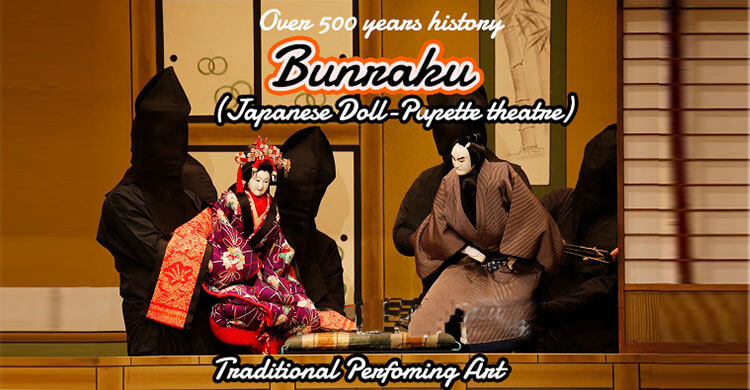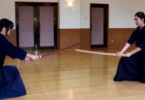Hello everyone how are you? Today’s theme is “Bunraku” (Japanese doll-puppet theater) which was recognized by UNESCO as an intangible cultural heritage in 2008, along with “Noh/Nohgaku“,and “Kabuki” that are also recognized as “Cool Japan”.
Contents
What are Japanese traditional performing arts?
As I mentioned the three classical performance arts listed on UNESCO, they are “Noh/Nohgaku“(Noh play,drama or Noh farce), “Bunraku” (Japanese doll-puppet theater), and “Kabuki“.
Frankly speaking, however, it’s difficult for even the Japanese to explain how three differences are if we haven’t seen them in theatre.
These are dramas born from the lives of ordinary people, so the content is trivial, such as tragedies, comedies, romances, small quarrels, and the like.
That’s because they are apparently quite similar, at first glance, to their performance on stage except masks on their face for Noh and Bunraku doll-puppet for Bunraku.
Here’s an outline of the three as follows,
★ Noh is a play based on classics using masks (The name of Predecessor “Sarugaku” has also been changed to “Noh” by combining Noh and “Kyogen” which was a comedy play/drama characterized by/featuring comical movements)
★ Bunraku is a play using Bunraku dolls (we talk it later)
★ Kabuki is entertainment for the masses
What’s Bunraku (Japanese doll-puppet theater) then?
With a history dating back over 500 years, Bunraku, also known as Ningyō jōruri, is a form of traditional Japanese puppet theatre, founded in Osaka in the beginning of 17th century.
Bunraku is older than Kabuki in history and it’s one of Japan’s distinctive traditional perfoming arts.
It combines puppet plays with joruri. stories narrated with musical accompaniment.
Jōruri is a form of traditional Japanese narrative music in which a tayū sings to the accompaniment of a shamisen. As a form of storytelling, the emphasis is on the lyrics and narration rather than the music itself.
And this is the latest trend that the number of foreign visitors to Bunraku theaters has been increasing even though they don’t seem to understand stories as language to be spoken there is Japanese.
However, earphones which you can enjoy listening in English are available in most theaters.
(Sorry to inform you that subtitles and/or narrations on three videos below are only in Japanese but I hope you get a taste of what’s Bunraku)
Duty and obligation, tragic love, the ties between parents and children. Bunraku features themes like these that resonate strongly with the Japanese people.
The stories acted out by the puppets are told through narration and music.
Looking at the stage, a platform can be seen on the right. It revolves to reveal the tayu, or narrator, and a shamisesn player.
The tayu provides an explanation of the action on stage and also recites the dialogue of all the characters.
This is done with a unique cadence and vocal style known as gidayu-bushi.
The tayu and shamisen player are in place and the puppets are ready on stage. The performance begins.
Most of the puppets are operated by three puppeteers. Even though the faces of the principal puppetees are visible, the audience focuses most on the intricate movements and expressions of the puppets.
There are many kinds of Bunraku puppets. They feature a number of ingenious mechanisms.
The head is the most important part of a puppet. There are around 30 different male heads and 10 female heads.
Each Bunraku puppet consists simply of a head and torso. Male puppets have arms and legs connected with strings, while female puppets have no legs at all. It’s the way the costumes are arranged over these parts and the movements of the puppeteers that give the puppets lifelike bodies.
The puppets’ expressions are so vivid you imagine you can hear them breathing. Sometimees they cry and sometimes they laugh. They are brought to life by the exquisite skill of the puppeteers.
The way the head is moved can also change the expression. Tilting it downwards gives the face a rather sombre look. Cocking the head upwards produces a more cheerful look. Subtle changes like this can produce a wide range of expressions.
On this head of a young woman, there is a pin fitted beside the mouth. It’s used to hold a cloth or the sleeve of the woman’s kimono in place. She seems to be biting on the fabric while shaking her head, portraying a state of emotional suffering.
Once you go to the theater and watch it, you will surely become a fan of traditional perfoming arts. If you have time, we are waiting for you, thanks









